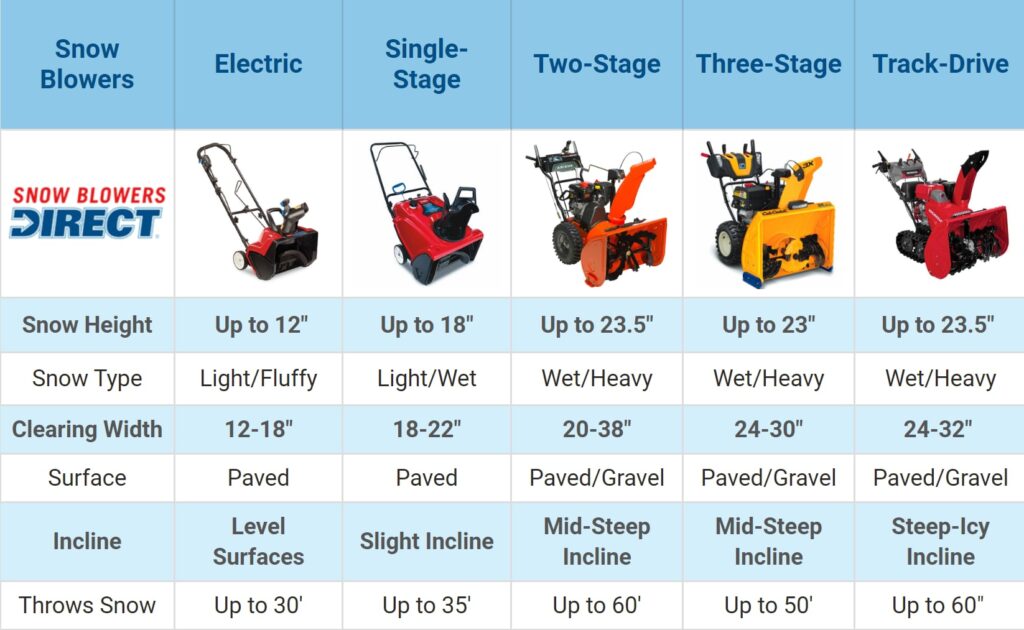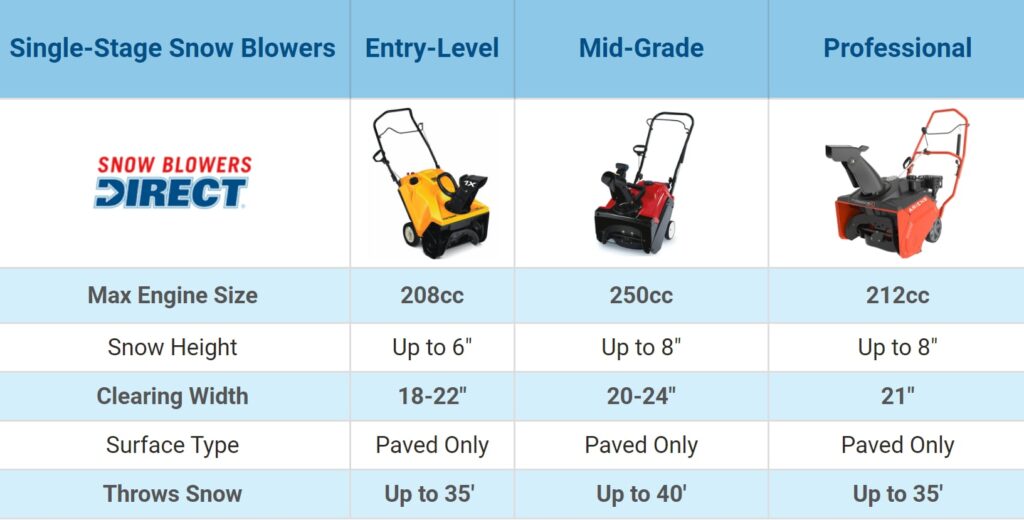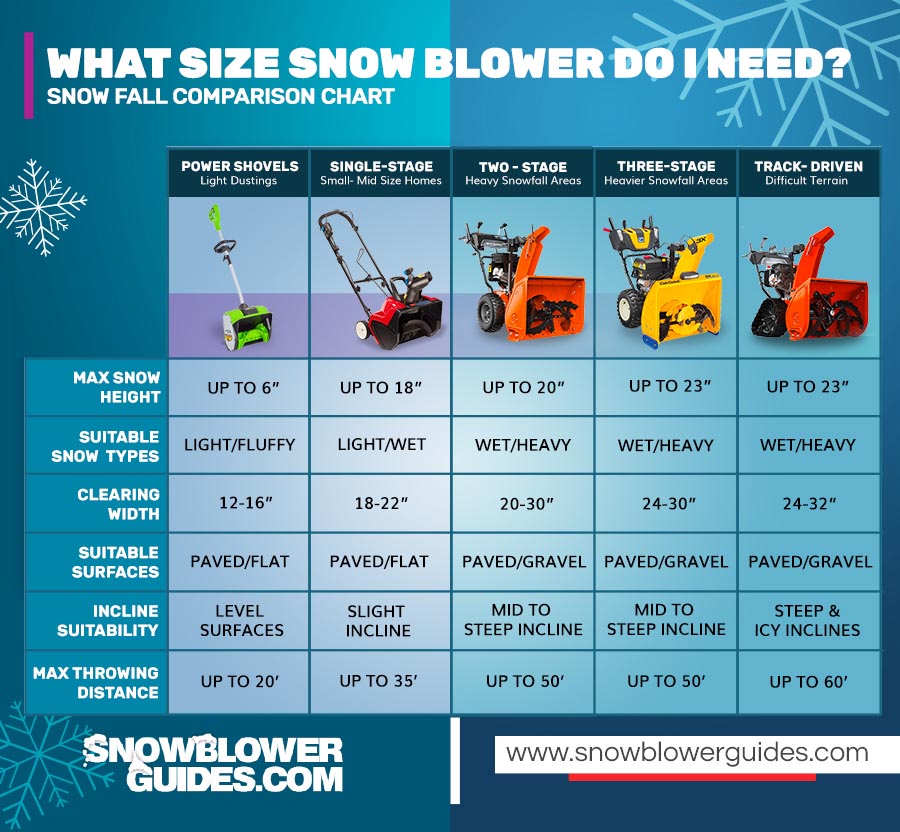Are you tired of spending hours shoveling snow in the freezing cold every winter? Well, fret not, because we’ve got the perfect solution for you – a snow thrower! But before you head out and purchase one, you might be wondering, “What size snow thrower do I need?” After all, there are so many options available in the market. In this article, we will help you navigate through the confusing world of snow throwers and provide you with all the information you need to make an informed decision. So sit back, relax, and let us guide you towards finding the perfect snow thrower for your needs.
Factors to Consider
When it comes to selecting the right snow thrower for your needs, there are several important factors to consider. By taking these factors into account, you can ensure that you choose a snow thrower that is efficient, effective, and suited to the specific conditions of your property.
Size of the Area
The size of the area you need to clear is a crucial factor to consider when choosing a snow thrower. If you have a small driveway or walkway, a compact and lightweight snow thrower may be sufficient. However, if you have a large driveway or regularly deal with heavy snowfall, you may require a more powerful and robust snow thrower to tackle the job effectively.
Type of Snow
The type of snow you typically encounter is another key consideration. Light, fluffy snow is easier to remove and may not require as much power as heavy, wet snow. If you live in an area with consistent heavy snowfall, you may want to choose a snow thrower that can handle these more challenging conditions.
Terrain
The terrain of your property can also impact your choice of snow thrower. If you have a flat and even surface, most snow throwers will be suitable. However, if you have slopes or uneven terrain, you may want to choose a snow thrower with enhanced traction and maneuverability to ensure safe and efficient operation.
Frequency of Use
Consider how often you will be using the snow thrower. If you only need to clear snow occasionally, a smaller and more affordable snow thrower may suffice. On the other hand, if you live in an area with frequent snowstorms, investing in a higher capacity snow thrower may be more practical in the long run.
Budget
Your budget is another important factor to take into account. Snow throwers come in a range of prices, so it’s important to consider what you can afford while still meeting your specific needs. Keep in mind that more expensive models may offer additional features and higher performance, but you should choose a snow thrower that fits within your budgetary constraints.
Types of Snow Throwers
There are three main types of snow throwers: single-stage, two-stage, and three-stage. Each type has unique features and strengths, so it’s essential to understand their differences to choose the right one for you.
Single-Stage Snow Throwers
Single-stage snow throwers are typically lightweight and compact, making them ideal for small to medium-sized areas. They use an auger to scoop up the snow and propel it out through a chute. Single-stage snow throwers are best suited for light to moderate snowfall and can handle up to 8-12 inches of snow depth.
Working Mechanism
Single-stage snow throwers have a single rotating auger that performs both the snow removal and propulsion functions. As the auger spins, it collects the snow and throws it out through the chute, clearing the path as you move forward.
Ideal Area Size
Single-stage snow throwers are best suited for areas up to 20 inches wide and 8-12 inches deep. They are ideal for small driveways, sidewalks, and decks.
Pros
- Lightweight and easy to maneuver
- Compact size for easy storage
- Affordable compared to other types
- Suitable for light to moderate snowfall
Cons
- Less powerful than two- or three-stage snow throwers
- Limited clearing width and depth
- Not suitable for heavy snow or icy conditions
Two-Stage Snow Throwers
Two-stage snow throwers are more powerful and versatile than single-stage models. They feature an auger that collects the snow, and a separate impeller that throws the snow out through the chute. Two-stage snow throwers can handle larger areas and more substantial snowfall, making them a popular choice for many homeowners.
Working Mechanism
In two-stage snow throwers, the first stage involves the auger scooping up the snow and breaking it into smaller pieces. The impeller then throws the broken snow out through the chute, allowing for efficient clearing of larger areas and heavier snow.
Ideal Area Size
Two-stage snow throwers are suitable for areas wider than 20 inches and can handle deeper snow accumulation, often up to 18 inches or more. They are ideal for medium to large driveways, pathways, and commercial properties.
Pros
- More powerful and effective in heavy or compacted snow
- Greater clearing capacity than single-stage models
- Suitable for larger areas and heavier snowfall
- Can handle icy or hard-packed snow
Cons
- More expensive than single-stage snow throwers
- Bulkier and heavier, making them slightly harder to maneuver
- Requires more storage space
Three-Stage Snow Throwers
Three-stage snow throwers are the most powerful and capable machines on the market. They feature a third accelerator auger, in addition to the standard auger and impeller found in two-stage models. This third auger helps break up even the heaviest and most compacted snow, making three-stage snow throwers a top choice for demanding winter conditions.
Working Mechanism
Three-stage snow throwers work similarly to two-stage models, but with the added benefit of the accelerator auger. As the snow is collected by the standard auger, the accelerator auger helps break it into finer pieces, resulting in faster and more efficient snow clearance.
Ideal Area Size
Three-stage snow throwers are suitable for larger areas, similar to two-stage models. They perform exceptionally well in heavy snowfall and can handle snow depths of 18 inches or more. These snow throwers are often preferred by those with large properties or areas prone to heavy snow accumulation.
Pros
- Extremely powerful and efficient in all types of snow
- Excellent clearing capacity for large areas
- Can handle deep snow accumulation and heavy-duty work
- Ideal for commercial use or properties with heavy snowfall
Cons
- More expensive than single- and two-stage models
- Bulky and heavy, requiring more storage space
- Less maneuverable than single-stage snow throwers

This image is property of www.snowblowersdirect.com.
Clearing Width and Intake Height
When choosing a snow thrower, it’s essential to consider the clearing width and intake height. These features determine the machine’s clearance capacity, allowing you to clear more snow in a shorter time.
Determining the Clearance Capacity
The clearance capacity refers to the amount of snow a snow thrower can handle in a single pass. It’s calculated by multiplying the clearing width by the intake height. For example, a snow thrower with a 24-inch clearing width and a 20-inch intake height has a clearance capacity of 480 square inches.
Importance of Clearing Width
The clearing width determines the width of the snow path the snow thrower can clear in one pass. A wider clearing width allows for more efficient and faster snow removal, reducing the number of passes required to clear your desired area.
Impact of Intake Height
The intake height is the maximum depth of snow that the snow thrower can handle. Choosing a snow thrower with an adequate intake height ensures that it can effectively clear the depth of snow you typically encounter.
Consideration for Driveways and Sidewalks
When selecting a snow thrower, consider the width of your driveway or sidewalk. Ensure that the clearing width of the snow thrower is wide enough to efficiently clear your chosen path. Similarly, if you typically experience deeper snow accumulation, opt for a snow thrower with a higher intake height to handle these conditions effectively.
Engine Power and Drive System
The engine power and drive system of a snow thrower are crucial factors to consider, as they determine the machine’s performance and handling capabilities.
Engine Power Options
Snow throwers are available with various engine power options, typically measured in horsepower (HP) or cubic centimeters (cc). Higher horsepower or engine displacement generally indicates a more powerful snow thrower capable of handling heavier snow or more challenging terrain.
Consideration for Variable Speed Drive System
Some snow throwers feature a variable speed drive system that allows you to adjust the machine’s forward movement speed. This feature is particularly useful when dealing with different snow conditions or when operating on slopes. A variable speed drive system provides greater control and maneuverability, ensuring you can safely and efficiently clear your property.

This image is property of www.snowblowersdirect.com.
Electric vs. Gas-Powered
When choosing a snow thrower, you will need to decide between an electric or gas-powered model. Each type has its advantages, so consider your specific needs and preferences before making a decision.
Advantages of Electric Snow Throwers
Electric snow throwers are quieter, require less maintenance, and eliminate the need for fuel mixing. They are generally lighter and more compact, making them easier to maneuver and store. Electric models are also more environmentally friendly since they produce no exhaust emissions.
Advantages of Gas-Powered Snow Throwers
Gas-powered snow throwers are typically more powerful, making them better suited for heavy snowfall or larger areas. They offer greater mobility since they do not rely on an electrical outlet and can operate for longer periods without needing to be recharged. Gas-powered models are also more versatile, as they can handle various snow conditions, including ice and compacted snow.
Choosing the Right Type
To determine whether an electric or gas-powered snow thrower is right for you, consider the size of your property, the frequency of use, and the snow conditions you typically encounter. If you have a small to medium-sized property with light to moderate snowfall and prefer a quieter and low-maintenance option, an electric snow thrower may be ideal. However, if you have a larger property or frequently experience heavy snow or mixed winter conditions, a gas-powered snow thrower may offer the power and versatility you need.
Additional Features
Snow throwers can come with various additional features that can enhance your snow clearing experience, providing added convenience and comfort.
Controls and Maneuverability
Look for snow throwers with easy-to-use controls and intuitive maneuverability. Features like ergonomic handles and smooth steering mechanisms can make operating the snow thrower more comfortable and efficient, reducing strain and fatigue.
Chute Control
Chute control allows you to adjust the direction and distance at which the snow is thrown. Look for snow throwers with easy-to-use chute control mechanisms that allow for quick and precise adjustments. Some models even offer remote chute control, allowing you to adjust the chute direction without stopping or dismounting the machine.
Headlights and Heated Grips
Snow removal often takes place in low-light conditions, so having headlights on your snow thrower can be incredibly beneficial. They provide visibility and ensure safe operation, especially in the early morning or evening hours. Additionally, heated grips on the handles can keep your hands warm and comfortable during prolonged use.
Weight and Portability
Consider the weight and portability of the snow thrower, especially if you have limited storage space or need to transport the machine frequently. Lighter and more compact models are easier to store and maneuver, particularly if you need to navigate tight spaces or transport the snow thrower between properties.

This image is property of www.snowblowerguides.com.
Maintenance and Storage
To ensure the longevity and optimal performance of your snow thrower, proper maintenance and storage are essential.
Routine Maintenance
Regular maintenance of your snow thrower is important to keep it in good working condition. This includes checking and replacing spark plugs, changing the oil, and inspecting the belts and augers for wear. It’s also crucial to follow the manufacturer’s specific maintenance guidelines outlined in the owner’s manual.
Proper Storage
When the winter season is over, it’s crucial to properly store your snow thrower to protect it from damage and corrosion. Clean off any excess snow and debris, and ensure all moving parts are lubricated. Store the snow thrower in a dry and covered area, away from moisture and extreme temperatures.
Winterizing Your Snow Thrower
Before the winter season begins, it’s important to properly prepare your snow thrower. This includes checking the fuel system, ensuring the engine is properly lubricated, and inspecting the machine for any needed repairs. Winterizing your snow thrower will help ensure it starts easily and performs optimally when you need it most.
In conclusion, choosing the right snow thrower involves considering various factors such as the size of the area, type of snow, terrain, frequency of use, and budget. Understanding the different types of snow throwers, their working mechanisms, ideal area sizes, pros, and cons will help you make an informed decision. Additionally, considering factors like clearing width and intake height, engine power and drive system, electric vs. gas-powered options, additional features, and maintenance and storage requirements will further assist you in selecting the perfect snow thrower that suits your specific needs.
